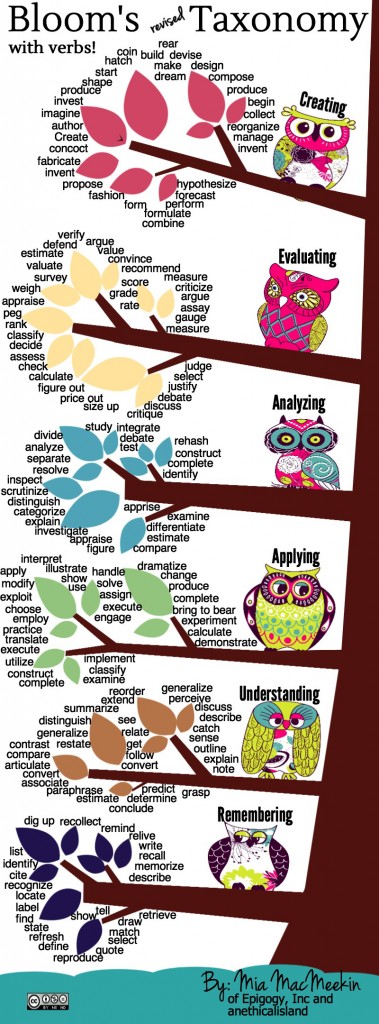There is much discussion about how teachers across the country are integrating Bloom’s Taxonomy in their lesson planning and if the instruction includes high level thinking skills to challenge students in a ‘this century’ classroom.
Many teachers work tirelessly to integrate the various levels of Bloom’s so students can reap the full benefit of being a life-long learner. Other times you read pages of lesson plans and all that’s ever integrated into the instruction is the lower level thinking skills that include remembering and understanding (formerly known as knowledge & comprehension), along with some application.
While it is integral for us to include the bottom levels of Bloom’s (after all, we need to introduce the lesson, explain the importance of the event, and provide the background information,) we must think about what instruction and learning would look like if we integrated all levels of Bloom’s, from bottom to top, as appropriate to the lesson.
By using the chart above or referencing other resources, we can pinpoint what we need to teach and how we will teach it.
For example we could look at a social studies lesson plan on the use of the Atomic Bomb to end World War II. Typically we would have students read and memorize key terms and facts. While this information is the basis for the lesson, all we’ve included for the student is lower level thinking skills. Students can memorize and regurgitate the information, but they’re not using any higher level thinking skills that will help with long-term learning or motivate them to think for themselves.
Perhaps a better approach to this lesson (after you’ve had time to provide the background information and share through classroom discussions) is to ask students to write a paragraph ‘evaluating/judging’ Truman’s decision to drop the atomic bomb. We can still have students learn key terms or significant decisions through this assignment, but now we’ve asked students to formulate an argument and/or support an argument based on information they have researched and learned. Because students are having to craft this short written piece, they have single-handedly had to formulate their own thoughts about the war and how Truman’s decision impacted this country and the world.
Another option would be to ask students to debate the pros and cons of dropping the atomic bomb. This would require some research on their part, but the value of analyzing and evaluating this information allows students to take ownership of their learning and stretch their learning far beyond the traditional memorization.


I love the owl Bloom’s poster! I also like the simple list of Bloom’s verbs that is included in the resources link that you provided. An excellent resource that can be used both by me and my students! Thank you!